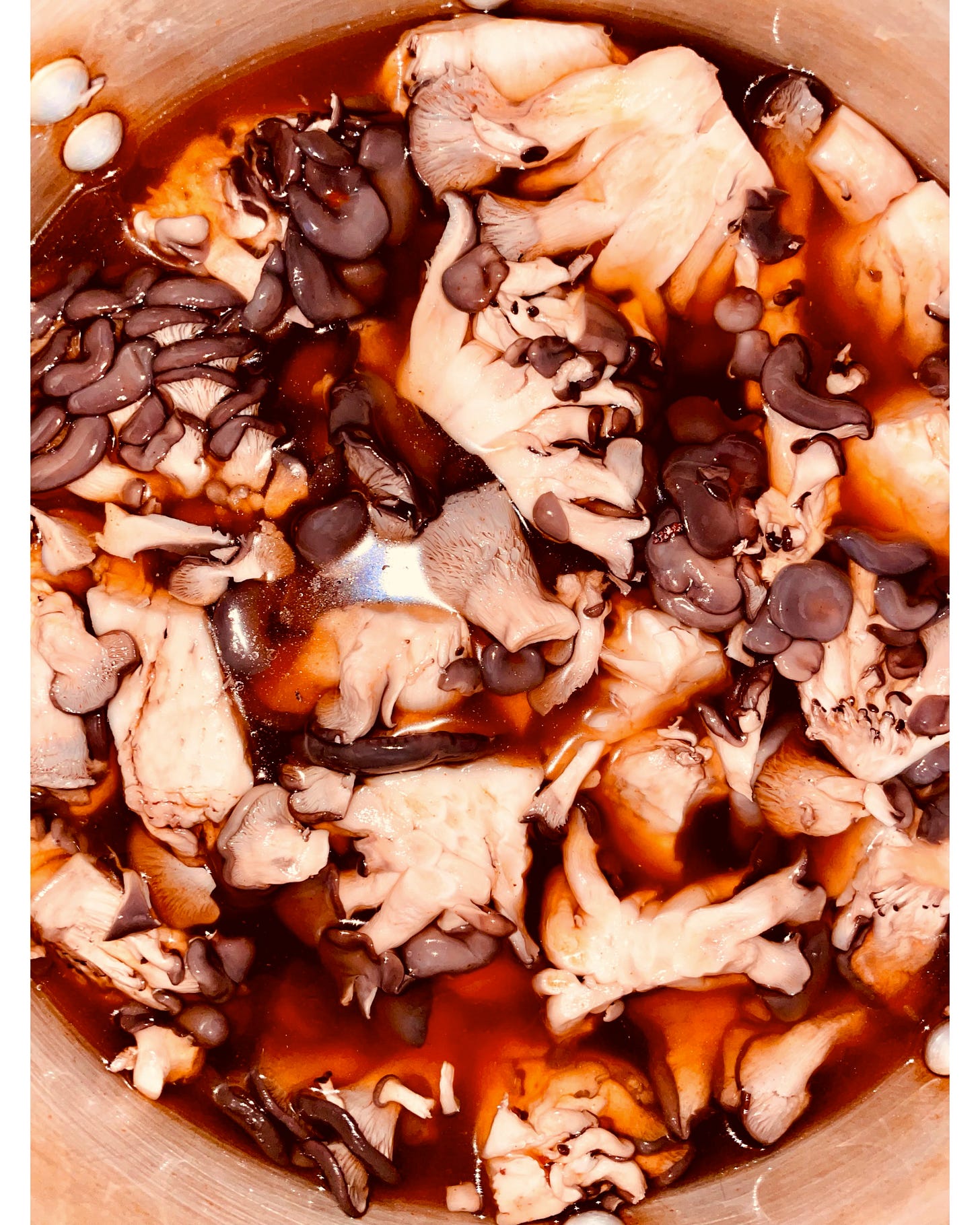On Mushrooms
A newsletter ending with a recipe and a theory of how we might all just be human smoothies for a fungus that may or may not solely exist in my dreams/nightmares.
Hubris will lead you to wild assumptions; ones that make you believe you can defy nature. It’s never been a fair fight between us and the other, (nature, the outside, the environment, instinct), because everything is set up in our world by the other. (Are you still here? Can you believe this will eventually lead to a recipe?)
I’ve been obsessed with getting mushrooms, specifically Oyster Mushrooms, to mimic a similar texture/flavor/feeling I get with a roast chicken. I’m typically averse to making non-meat into meat-like substances because there exists other cultures, (the majority, non-Western), that have been able to support a mostly vegetarian lifestyle without resorting to making non-bleeding ingredients bleed in a lab.
And with that caveat, I still cannot ignore the similarities in cooking a perfect roast chicken to a perfectly seared mushroom. There is something that happens when a chicken is right out of the oven, you can see it seize and crackle under the skin, and as much as I am an advocate for vegetarian diets, nothing can quite compare to the char, the smell, the carnal hominess of roasted chicken. Except maybe mushrooms.
During a night of testing out said mushrooms, my cat Bagheera began meowing and stalking the kitchen. These tester mushrooms went through a hot brine, a slow confit in the morning, then painted with a sauce to be lacquered in a hotter oven in the afternoon, now ready for different executions, held in a half pan. And it was that half hotel pan that drew Bagheera’s attention. Self satisfied at my skill in making these mushrooms manipulate a cat, I didn’t think to immediately doubt my prowess just yet until I did a Google check later in the night.
Cats aren’t like other animals, they tend to be really adept at limiting their food intake, knowing what is good for them to eat; they are discerning enough to know that meat is present, ready for taking. And especially for Bagheera, the presence of chicken is something he is highly attuned to, and specific in his behavior when he wants a bite.
My extremely photogenic catalyst of this story:
But mushrooms, because of their unique nature and evolution, are carnal in taste, with or without human manipulation. In fact, mushrooms produce a lot of the same amino acids present in meat that give that distinct Umami savory component, while nearly containing the same protein quality of meat. Cats, because of this composition, can recognize mushrooms as a good source of nutrition.
Mycelium is a vast, varied network of fungus that scientists theorize to be around 800 million years old, giving it the time to labor and make itself a major catalyst for Earth as we define it. Plants, animals, the environment, is all due to the carbon network of fungus constantly communicating, growing, shrinking, decomposing, and most importantly, evolving. Fungus, extracting minerals from mainly rocks, passed these nutrients along to plants, helping them grow and create the high oxygen atmosphere on Earth. In fact, it was after an asteroid hit Earth, 65 million or so years ago, wiping out most of the organisms thriving, came an opportune time for fungus to grow as rapidly as possible. Heralding giant forests, larger, bigger, badder plant life, changing the temperature of the Earth for warm-blooded organisms to be created. And if that isn’t enough of an undertaking, this fungus network became responsible custodians, decomposing everything. It is from fungus we were created and it is from fungus we will be broken down.
Mushrooms are like an art installation: projecting the labor and work happening beneath the ground, found near trees, coasts, forests, jungles all around the world, a sort of natural flag planted down to remind everyone who is actually in charge, (the largest organism on the planet is a fungus dwelling in Oregon). Some of these mushrooms are even edible, some are poisonous, some will change your entire being, giving you transformative experiences, and most of them, we still have no idea about; 14,000 mushrooms have been identified and that’s only 2 percent of the species itself.
And so this thing that has existed literally before time, (I go back and forth on the concept of time), still exists quite comfortably around us, how does it fit in our diet? For a lot of us, this is simple. Ones that don’t kill you, eat them. Mushrooms, as a culinary concept, are having a real moment here, it’s no longer considered alternative to eat or cook with them. Fast food chains are frying them right alongside their fried chicken sandwiches, and every food influencer I’ve seen has a video of cross-hatching a Trumpet mushroom, searing it and sprinkling it with scallions on a bed of white rice.
But the truth is that life is complicated, our food system is incredibly contradictory and difficult to navigate. It’s hard being a consumer with cognitive thinking. If you’ve looked up the words, “Oyster Mushroom”, together, you will have no doubt seen the many searches that ask if it’s vegan. Oyster Mushrooms, uniquely, are producers and predators, actually able to catch prey, specifically Nematodes, by poisoning them with strategic toxins within the first few moments of contact, injecting themselves onto the prey, absorbing their innards creating enough nitrate to continue to produce more of themselves. In short, vegans consuming these mushrooms are consuming animals.
Keep reading with a 7-day free trial
Subscribe to Sicc Palette to keep reading this post and get 7 days of free access to the full post archives.





